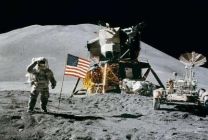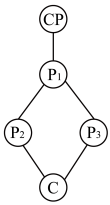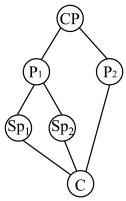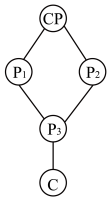1 . Every minute, every single day, the equivalent of a truckload of plastic enters our oceans. In the name of profit and convenience, corporations are literally choking (塞满) our planet with a substance that does not just “
Just over a decade ago, I launched the Story of Stuff to help shine a light on the ways we
The cycle is endless, and it happens countless times every single day. But here’s the
For years, we’ve been
Recycling alone will never stop the flow of plastics into our oceans; we have to get to the
Bag, cup and straw bans like those in Morocco, Iceland, Vancouver and some US cities are a great start, but also not enough. And while clean-up efforts are
Not long ago, we existed in a world without throwaway plastic, and we can thrive that way again. The world’s largest corporations—with all their profits and innovation labs—are well
| A.pass by | B.go away | C.give in | D.turn around |
| A.produce | B.pursue | C.consume | D.clear |
| A.desires | B.purchases | C.profits | D.varieties |
| A.needless | B.attractive | C.complete | D.permanent |
| A.significance | B.relief | C.instance | D.challenge |
| A.originates from | B.ends up | C.relates to | D.goes beyond |
| A.thrilled | B.frustrated | C.convinced | D.concerned |
| A.skillfully | B.randomly | C.simply | D.precisely |
| A.difference | B.proposal | C.discovery | D.choice |
| A.complexity | B.analysis | C.presence | D.source |
| A.mopping | B.screaming | C.complaining | D.regretting |
| A.Otherwise | B.Besides | C.However | D.Therefore |
| A.enthusiasm | B.responsibility | C.preference | D.demand |
| A.inadequate | B.helpful | C.voluntary | D.fruitless |
| A.educated | B.acknowledged | C.established | D.positioned |
2 . The Apollo Missions

“That's one small step for a man. One giant leap for mankind.”
— Neil Armstrong
Apollo’s Goals
The national effort that enabled Astronaut Neil Armstrong to speak those words as he stepped onto the lunar surface fulfilled a dream as old as humanity. Project Apollo’s goals went beyond landing Americans on the moon and returning them safely to Earth.
Apollo 13

Apollo 13 has been called a “successful failure,” because the crew never landed on the Moon, but they made it home safely after an explosion crippled their ship. When the associated heater was turned on during flight, the tank exploded depleting almost all of the power from the command module and forcing the crew to use the lunar module as a lifeboat. Jim Lovell, Fred Haise and Jack Swigert came home safely thanks to the mission control team’s improvised procedures and their own ability to implement them.(Launch: April 11, 1970; splashdown: April 17)
Apollo 14

Notable for the return of America’s first astronaut, Alan Shepard, to space, Apollo 14 also was probably the smoothest lunar landing to that point. The crew spent more than nine hours outside the lunar module and set up a number of experiments. Shepard set a new distance record by walking more than 9,000 feet on the lunar surface, pulling a hand cart to carry their tools and samples.(Launch: Jan. 31, 1971: lunar landing: Feb. 5: splashdown, Feb. 9)
Apollo 15

For the first time, humans drove a car on the Moon. The first of the Apollo “J” Missions-designed for longer stays on the Moon - the mission carried a lunar rover, which Commander David Scott and Lunar Module Pilot James Irwin used while they were on the surface for more than I8 hours. They traveled more than 17 miles in the rover, setting up experiments and collecting 170 pounds of samples. Before leaving the lunar surface, Scott conducted an experiment to test Galileo’s theory that objects in vacuum, without air resistance, would fall at the same rate. He dropped a geological hammer and a feather, which hit the ground at the same time, proving Galileo right.(Launch: July 26, 1971, lunar landing: July 30: splashdown: Aug. 7)
1. Why has Apollo 13 been called a “successful failure”?| A.Apollo 13 finally exploded as planned in space. |
| B.All the crew succeeded in landing on the Moon. |
| C.The crew managed to escape from a severe accident and returned to Earth. |
| D.The crew finished the experiment although they failed to land on the Moon. |
| A.It took five days for Apollo 14 to reach the Moon. |
| B.The lunar rover was used as a lifeboat for space travel. |
| C.Shepard tested Galileo’s theory successfully on the Moon. |
| D.Apollo 15 remained in space for the shortest period of time. |
| A.Booming Science | B.Exploring the Unknown |
| C.Mechanical World | D.Transforming Moon |
3 . In February 1970, a group of activists gathered in Vancouver, Canada to discuss a planned nuclear test on the Alaskan island of Amchitka. They eventually agreed to sail to the test site and
Over the last 50 years, the
The human species, which emerged in the green forests and grasslands of Africa about 300, 000 years ago, has a special
With the rise of farming, we started to use green as a(n)
The ancient Egyptians, who were farming the banks of the Nile from about 8000 B.C.,
| A.bump | B.protest | C.compete | D.insure |
| A.objected | B.announced | C.responded | D.highlighted |
| A.curious about | B.familiar with | C.shocked at | D.fascinated by |
| A.environmental | B.revolutionary | C.multicultural | D.deliberate |
| A.results | B.origins | C.extremes | D.streams |
| A.identified | B.recognized | C.combined | D.illustrated |
| A.physical | B.artificial | C.biological | D.physiological |
| A.engaged | B.evolved | C.dominated | D.exchanged |
| A.pioneers | B.seniors | C.ancestors | D.inspectors |
| A.sensitive | B.available | C.equivalent | D.appropriate |
| A.approach | B.symbol | C.alternative | D.signal |
| A.crossing over | B.counting for | C.according to | D.dating back |
| A.described | B.reflected | C.interpreted | D.resembled |
| A.eventually | B.similarly | C.consequently | D.definitely |
| A.agriculture | B.vegetation | C.cultivation | D.generation |
4 . During those barren winter months, with windows overlooking long-dead gardens, leafless trees, and lawns that seem to have an ashy look about them, nothing calms the uneasy nerves more than the vibrant green of plants surrounding the living spaces of one’s home. People browse through garden stores just to get a smell of chlorophyll (叶绿素) and to choose a plant or two to bring spring back into their winter-gray lives.
Now there is even more of a need for “the green,” in light of recent articles warning us of the dangers of chemicals that we, ourselves, introduce into our homes. Each time we bring clothes home from the cleaners, we release those chemicals into the closed-in air of our homes. Every cleanser releases its own kind of fumes.
Some of the chemicals are formaldehyde (甲醛), chlorine, benzene, styrene, etc. Read the labels on many home products, the ingredients aren’t even listed! During the winter, when those same windows are shut tight, we breathe in these chemicals—causing symptoms much like allergies (过敏). In fact, most people probably dismiss the effects of these chemicals simply as some allergy or other. The truth is that we are experiencing a syndrome that is called Multiple Chemical Sensitivity. Now, what has this got to do with green plants? Everything healthy! Research has been conducted with two types of plants that have actually removed much of these harmful chemicals from the air.
The two plants that seem to be the best bet for ridding one’s home of such chemicals are ferns (蕨类植物) and palms. These plants release moisture as part of photosynthesis and, as they do, pull chemicals from the air into their leaves. Even NASA has conducted some greenhouse experiments for long-term space exploration. Within hours, their plants [palms] had removed almost all traces of formaldehyde in the room. Both species of plants are ancient, dating back more than a hundred million years. Another trait they share is that they both live long lives, 100 years or more. This we expect from trees, but ferns and palms are plants; plants that can grow to 65 feet in the proper setting! Even their individual leaves live for one to two years [ferns] and one to nine years [palms]. Perhaps it is their primary qualities that have contributed to their ability to purify their environment.
1. Why does the author think we are in greater need of “the green” in our homes?| A.To bring our long-dead gardens back to life. |
| B.To get rid of harmful chemicals trapped there. |
| C.To make us feel calmer and less worried. |
| D.To serve as decorations as well as refresh us. |
| A.The source of these chemicals released in our homes hasn’t been identified. |
| B.The chemicals can be removed immediately the two plants are put into use. |
| C.People tend to underestimate the effects of the chemical in the closed-in places. |
| D.People usually buy household products without referring to the ingredients on them. |
| A.the ability to absorb chemicals and live long |
| B.their adaptability to indoor environment |
| C.the fast growth and attractiveness of their leaves |
| D.the release of their moisture and fumes |
| A.Research in the New Millennium |
| B.Common Houseplants May Purify Your Home |
| C.Hidden Dangers in Your Home |
| D.NASA Experiment Finds the Cure |
5 . Though people have discussed the relationship between science and nature for many years, there is no consensual(统一的) explanation. While some view science as a powerful tool in
Despite the different presentations of the concepts, though time separated the two men, both pieces express a similar view on the relationship between science and nature. Both pieces suggest that nature is
As Commoner’s article suggests, nature only allows science to have limited power and success. Both men believe that complete trust in science is
Commoner’s article clearly represents science as weak and useless, but more importantly, dangerous. It gives evidence to support the suggested dangers
| A.building | B.defining | C.showing | D.uncovering |
| A.concerns | B.views | C.findings | D.achievements |
| A.interests | B.ambitions | C.discoveries | D.thoughts |
| A.preventing | B.earning | C.destroying | D.breaking |
| A.mysterious | B.powerful | C.fantastic | D.special |
| A.prosperity | B.perfection | C.improvement | D.integrity |
| A.beliefs | B.experiences | C.actions | D.attempts |
| A.disappointing | B.meaningful | C.useless | D.significant |
| A.throws | B.expresses | C.holds | D.casts |
| A.improper | B.unbelievable | C.dangerous | D.unwise |
| A.reforms | B.failures | C.experiments | D.changes |
| A.controlled | B.digested | C.shared | D.applied |
| A.question | B.doubt | C.hope | D.use |
| A.provided | B.supplied | C.associated | D.compared |
| A.directly | B.especially | C.definitely | D.necessarily |
6 . Each year, backed up by a growing anti-consumerist movement, people are using the holiday season to call on us all to shop less.
Driven by concerns about resource exhaustion, over recent years environmentalists have increasingly turned their sights on our “consumer culture”. Groups such as The Story of Stuff and Buy Nothing New Day are growing as a movement that increasingly blames all our ills on our desire to shop.
We clearly have a growing resource problem. The produces we make, buy, and use are often linked to the destruction of our waterways, biodiversity, climate and the land on which millions of people live. But to blame these issues on Christmas shoppers is misguided, and puts us in the old trap of blaming individuals for what is a systematic problem.
While we complain about environmental destruction over Christmas, environmentalists often forget what the holiday season actually means for many people. For most, Christmas isn’t an add-on to an already heavy shopping year. In fact, it is likely the only time of year many have the opportunity to spend on friends and family, or even just to buy the necessities needed for modern life.
This is particularly, true for Boxing Day, often the target of the strongest derision(嘲弄) by anti-consumerists. While we may laugh at the queues in front of the shops, for many, those sales provide the one chance to buy items they’ve needed all year. As Leigh Phillips argues, “this is one of the few times of the year that people can even hope to afford such ‘luxuries’, the Christmas presents their kids are asking for, or just an appliance that works.”
Indeed, the richest 7% of people are responsible for 50% of greenhouse gas emissions. This becomes particularly harmful when you take into account that those shopping on Boxing Day are only a small part of our consumption “problem” anyway. Why are environmentalists attacking these individuals, while ignoring such people as Russian billionaire Roman Abramovich, who has his own£1.5bn yacht with a missile defence system?
Anyway, anti-consumerism has become a movement of wealthy people talking down to the working class about their life choices, while ignoring the real cause of our environmental problems. It is no wonder one is changing their behaviours—or that environmental destruction continues without any reduction in intensity.
1. It is indicated in the 1st paragraph that during the holiday season, many consumers .| A.ignore resource problems |
| B.are fascinated with presents |
| C.are encouraged to spend less |
| D.show great interest in the movement. |
| A.has targeted the wrong persons |
| B.has achieved its intended purposes |
| C.has taken environment-friendly measures |
| D.has benefited both consumers and producers |
| A.madness about life choices |
| B.discontent with rich lifestyle |
| C.ignorance about the real cause |
| D.disrespect for holiday shoppers |
| A.anything less than a responsibility | B.nothing more than a bias |
| C.indicative of environmental awareness | D.unacceptable to ordinary people |
| A. double B. intense C. pressures D. stock E. agriculture F. trapped G. withdrawal H. availability I. drive J. expanding K. rising |
Throughout history, people have fought bitter wars over political ideology, national sovereignty and religious expression. How much more
Less than three percent of the planet’s
Global
“In wilderness(荒野) is the preservation of the world.” This is a famous saying from a writer regarded as one of the fathers of environmentalism. The frequency with which it is borrowed mirrors a heated debate on environmental protection: whether to place wilderness at the heart of what is to be preserved.
As John Sauven of Greenpeace UK points out, there is a strong appeal in images of the wild, the untouched; more than anything else, they speak of the nature that many people value most dearly. The urge to leave the subject of such images untouched is strong, and the danger exploitation(开发) brings to such landscapes(景观) is real. Some of these wildernesses also perform functions that humans need—the rainforests, for example, store carbon in vast quantities. To Mr.Sauven, these ”ecosystem services” far outweigh the gains from exploitation.
Lee Lane, a visiting fellow at the Hudson Institute, takes the opposing view. He acknowledges that wildernesses do provide useful services, such as water conservation. But that is not, he argues, a reason to avoid all human presence, or indeed commercial and industrial exploitation. There are ever more people on the Earth, and they reasonably and rightfully want to have better lives, rather than merely struggle for survival. While the ways of using resources have improved, there is still a growing need for raw materials, and some wildernesses contain them in abundance. If they can be tapped without reducing the services those wildernesses provide, the argument goes, there is no further reason not to do so. Being untouched is not, in itself, a characteristic worth valuing above all others.
I look forwards to seeing these views taken further, and to their being challenged by the other participants. One challenge that suggests itself to me is that both cases need to take on the question of spiritual value a little more directly. And there is a practical question as to whether wildernesses can be exploited without harm.
This is a topic that calls for not only free expression of feelings, but also the guidance of reason. What position wilderness should enjoy in the preservation of the world obviously deserves much more serious thinking.
1. John Sauven holds that_____.
| A.many people value nature too much |
| B.exploitation of wildernesses is harmful |
| C.wildernesses provide humans with necessities |
| D.the urge to develop the ecosystem services is strong |
| A.The exploitation is necessary for the poor people. |
| B.Wildernesses cannot guarantee better use of raw materials. |
| C.Useful services of wildernesses are not the reason for no exploitation. |
| D.All the characteristics concerning the exploitation should be treated equally. |
| A.Objective. | B.Disapproving. | C.Sceptical. | D.Optimistic. |
CP: Central Point P: Point Sp: Sub-point(次要点) : Conclusion
A. | B. | C. | D. |
9 . El Nino, a Spanish term for “the Christ child”, was named by South American fisherman who noticed that the global weather pattern, which happens every two to seven years, reduced the amount of fishes caught around Christmas. El Nino sees warm water, collected over several years in the western Pacific, flow back eastwards when winds that normally blow westwards weaken, or sometimes the other way round.
The weather effects both good and bad, are felt in many places. Rich countries gain more from powerful Nino, on balance, than they lose. A study found that a strong Nino in 1997 helped American’s economy grow by 15 billion, partly because of better agricultural harvest, farmers in the Midwest gained from extra rain. The total rise in agricultural in rich countries in growth than the fall in poor ones.
But in Indonesia extremely dry forests are in flames. A multi-year drought (干旱)in south-east Brazil is becoming worse. Though heavy rains brought about by El Nino may relieve the drought in California, they are likely to cause surface flooding and other disasters.
The most recent powerful Nino, in 1997-98, killed around 21,000 people and caused damage worth $36 billion around the globe. But such Ninos come with months of warning, and so much is known about how they happen that governments can prepare. According to the Overseas Development Institute (ODI), however, just 12% of disaster-relief funding in the past two decades has gone on reducing risks in advance, rather than recovery and rebuilding afterwards. This is despite evidence that a dollar spent on risk-reduction saves at least two on reconstruction.
Simple improvements to infrastructure (基础设施)can reduce the spread of disease. Better sewers (下水道)make it less likely that heavy rain is followed by an outbreak of the disease of bad stomach. Stronger bridges mean villages are less likely to be left without food and medicine after floods. According to a paper in 2011 by Mr Hsiang and co-authors, civil conflict is related to El Nino’s harmful effects—and the poorer the country, the stronger the link. Though the relationship may not be causal, helping divided communities to prepare for disasters would at least reduce the risk that those disasters are followed by killing and wounding people. Since the poorest are least likely to make up for their losses from disasters linked to El Nino, reducing their losses needs to be the priority.
1. What can we learn about El Nino in Paragraph 1?| A.It is named after a South American fisherman. |
| B.It takes place almost every year all over the world. |
| C.It forces fishermen to stop catching fish around Christmas. |
| D.It sees the changes of water flow direction in the ocean. |
| A.Agricultural harvests in rich countries fall. |
| B.Droughts become more harmful than floods. |
| C.Rich countries’ gains are greater than their losses. |
| D.Poor countries suffer less from droughts economically. |
| A.more investment should go to risk reduction |
| B.governments of poor countries need more aid |
| C.victims of El Nino deserve more compensation |
| D.recovery and reconstruction should come first |
| A.To introduce El Nino and its origin. |
| B.To explain the consequences of El Nino. |
| C.To show ways of fighting against El Nino. |
| D.To urge people to prepare for El Nino. |
10 . Otters, are cute, this no one can deny. They have big eyes, short and flat noses and claws (爪子) like tiny hands. They look even cuter when they wear hats and throw food balls into their mouths as if they were bar snacks, like Takechiyo, a pet otter in Japan. Documenting Takechiyo’s funny behavior has earned his owner nearly 230,000 followers on Instagram, a photo-sharing app.
Takechiyo’s fame reflects a craze across east and South-East Asia for keeping the cute creatures as pets. Enthusiasts in Japan visit cafés where they pay to hug them; Indonesian owners parade their pets around on leads or go swimming with them, then share their pictures online. But these enjoyable photos mask a trade that is doing a lot of damage. Even before they became fashionable companions for humans, Asia’s wild otters faced plenty of threats. Their habitats are disappearing. They have long been hunted for their coats, or killed by farmers who wish to prevent them consuming fishes. The pet trade, which began picking up in the early 2000s but appeared to speed up a few years ago, has made things worse. The numbers of wild Asian small-clawed otters and smooth-coated otters, two species that are in highest demand, have declined by at least 30% in the three decades to 2019.
The international agreement that governs trade in wildlife, known as CITES, now prohibits cross-border trade in these species. But laws banning ownership are often poorly implemented, as in Thailand, or full of holes, as in Indonesia. And the otter-keeping craze has been dramatically improved by the internet, says Vincent Nijman of Oxford Brookes University. In 2017 TRAFFIC, a British charity that monitors the wildlife trade, spent nearly five months looking at Facebook and other social-media sites in five South-East Asian countries. During that time, it found around 1,000 otters advertised for sale online.
In any case, otters do not even make particularly good pets. Every year the Jakarta Animal Aid Network, a charity in Indonesia’s capital, receives some ten otters from people who have struggled to look after them. Faizul Duha, the founder of an Indonesian otter-owners’ group, admits that his two animals emit a “very specific” (read: fishy) smell. They bite humans and chew on furniture. Their scream can be heard blocks away. And their cages need cleaning every two-to-three hours. That is how often they empty their bowels (肠道).
1. The function of the first paragraph is to ________.| A.present the main idea | B.introduce the main topic |
| C.set readers thinking | D.illustrate the writer’s point |
| A.The demand for pet otters. | B.The disappearance of otters’ habitats. |
| C.The popularity of otter coats. | D.The decrease of fishes. |
| A.the laws that prohibit cross-border trade are strict in Asia |
| B.social media plays a significant role in the online otter trade |
| C.people usually give up otters because they are endangered |
| D.otters are suitable pets because they are friendly to humans |
| A.advertise for a photo-sharing app |
| B.introduce the popularity of pet otters |
| C.discourage the illegal otter pet trade |
| D.describe the characteristics of otters |



